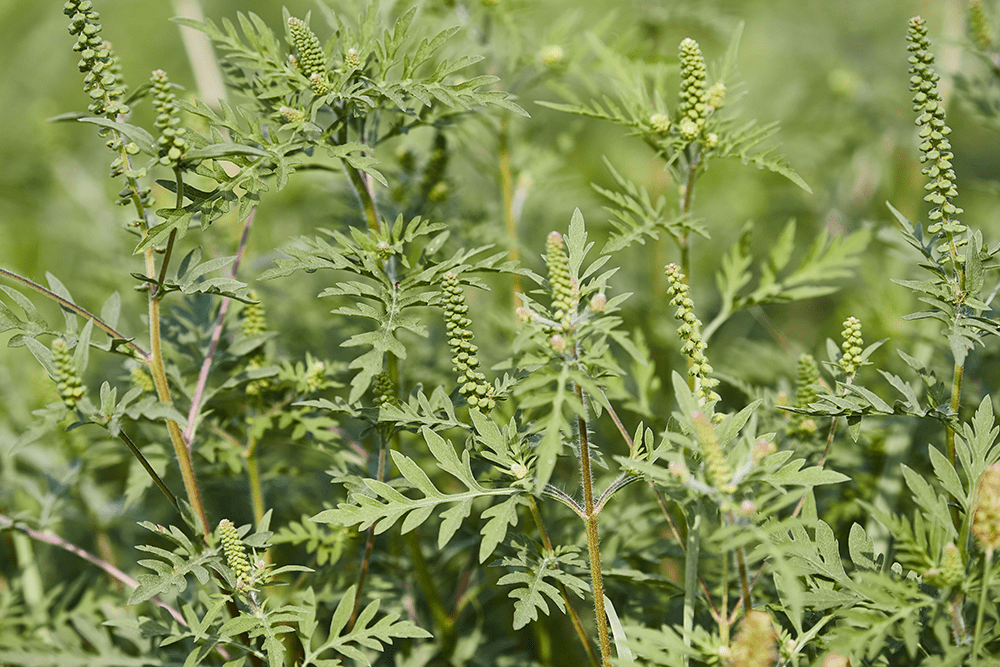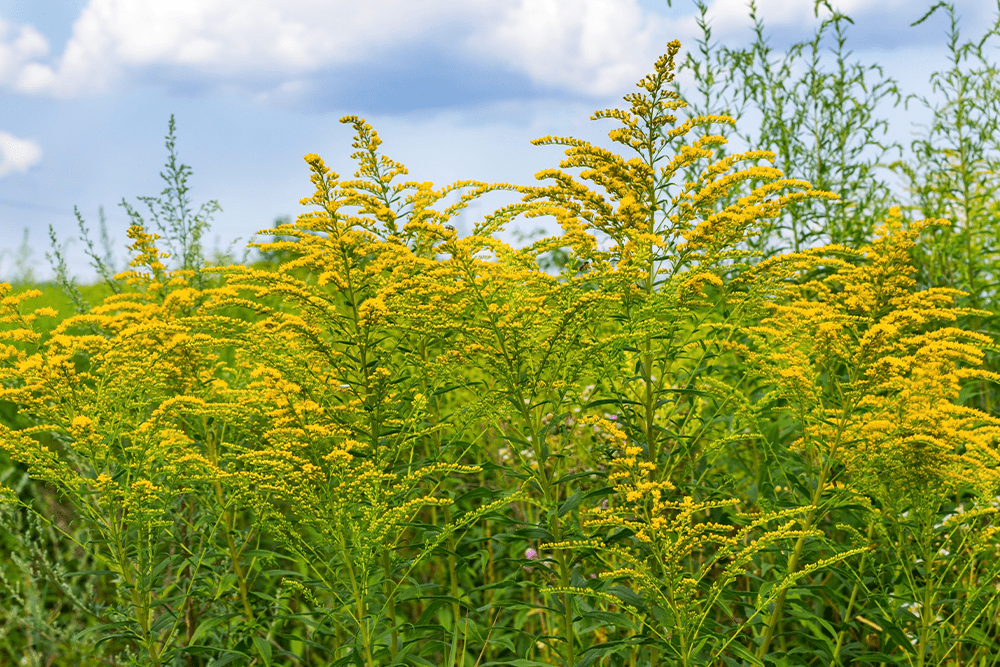Allergies
Ragweed Pollen Allergy
You may start having symptoms when ragweed plants release pollen into the air. Your symptoms may continue until the first frost kills the plant. Depending on your location, ragweed season starts around August and may last six to 10 weeks. In most areas in the U.S., it peaks in mid-September and can last through October.2
What Is Ragweed?
Ragweed is a weed that grows throughout the United States, especially in the Eastern and Midwestern states. Each plant lives only one season. But that one plant can produce up to 1 billion pollen grains.2
When nights grow longer, ragweed flowers mature and release pollen. Warm weather, humidity, and breezes after sunrise help release the pollen.
Ragweed usually grows in rural areas but can be found in suburban and urban areas too. Turf grasses and other perennial plants easily overgrow ragweed. But where streams of water, farming, or chemicals upset the soil – like salting roads in the winter – ragweed will grow. It is often found along roadsides, riverbanks, in vacant lots, and fields. Dormant seeds that live in the soil for decades may grow when the conditions are right.
One study showed that ragweed pollen could be seven times higher in a city that averaged 3.6 degrees warmer and had 30% more carbon dioxide than the city’s rural surrounding area.3 This is due to extreme heat in urban areas that are made worse because of an effect called an “urban heat island.”4
Some studies have shown that climate change has made the ragweed pollen season longer and more intense. This is a major cause of increased pollen. Ragweed plants are releasing pollen for longer periods during the year and the plants are releasing higher pollen amounts. Climate change is also causing increased carbon dioxide gas in the air, which stimulates ragweed plants to make more pollen.
What Are the Differences Between Ragweed and Goldenrod?
Ragweed and goldenrod are two types of plants that look very similar. While ragweed can cause allergy symptoms, goldenrod attracts insect pollinators, such as bees.
Some of the confusion comes from the fact that the two types of plants bloom at the same time. Here are some characteristics to help you tell the difference between the two.
Ragweed
- Greenish flowers on tall spikes
- Wind-blown pollen
- Branches out into many branches from the bottom up
- Annual – meaning it grows and dies within a year

Goldenrod
- Bright, yellow flowers
- Heavier pollen that is carried by insects
- Single stem that branched out at the top of the plant
- Perennial – meaning it grows back every year

What Is a Ragweed Pollen Allergy?
If you have allergies, your immune system reacts when you come in contact with allergens. When you are allergic to ragweed pollen and inhale it from the air, allergy symptoms may appear.
Seventeen types of ragweed grow in North America.5 Tooth-leaved ragweed is the type of ragweed that causes allergy symptoms for most people.2 Ragweed also belongs to a larger family of plants that can spread pollen by wind. These plants can also cause symptoms. Members of this plant family include:
- Sage
- Burweed marsh elder
- Rabbit brush
- Mugwort
- Groundsel bush
- Eupatorium
What Are the Symptoms of Ragweed Pollen Allergy? (Seasonal Allergic Rhinitis)
If you have a ragweed pollen allergy, you will only have symptoms when ragweed pollen is in the air. This is called seasonal allergic rhinitis, or “hay fever.” Symptoms of allergic rhinitis include:
- Runny nose (also known as rhinorrhea – this is typically a clear, thin nasal discharge)
- Stuffy nose (due to blockage or nasal congestion – one of the most common and troublesome symptoms)
- Postnasal drip (mucus runs from the back of your nose down your throat)
- Sneezing (can be repetitive and severe in some cases)
- Itchy nose, eyes, ears, and mouth
- Red and watery eyes
- Swelling around the eyes
- Moody and irritable
- Tired
- Disturbed sleep
If you have asthma and are allergic to ragweed pollen, you may have allergic asthma. This means ragweed pollen triggers your asthma symptoms:
- Cough
- Wheeze
- Shortness of breath
- Chest tightness or pain
A ragweed pollen allergy can also cause you to have itching or swelling in or around your mouth when you eat certain foods. This is called pollen food allergy syndrome (PFAS) or oral allergy syndrome (OAS). PFAS occurs because your immune system confuses ragweed pollen with certain foods. (It can happen to people allergic to some trees, grasses, or other weeds as well.)
If you have a ragweed allergy, you may get PFAS symptoms when you eat these foods:
- Banana
- Cantaloupe
- Cucumber
- Honeydew
- Watermelon
- White potato
- Zucchini
- Sunflower seeds
How Do Doctors Diagnose Ragweed Pollen Allergy?
If you think you are allergic to ragweed pollen, see a board-certified allergist. They will ask you about your medical history, do a physical exam, and allergy testing. They may do a skin prick test to confirm your allergy.
For prick/scratch testing, the doctor or nurse places a small drop containing ragweed pollen on your skin. They will then lightly prick or scratch your skin with a needle through the drop. If you are sensitive to ragweed, you will develop redness, swelling, and itching at the test site within 15 to 20 minutes. Your doctor may also do a blood test to see if you have the antibody to ragweed.
What Is the Treatment for Ragweed Pollen Allergy?
There is no cure for ragweed pollen allergy. But there are ways to treat and manage it. There are many allergy treatment options to help you.
- Track the pollen count for your area. The news media often reports the count for your area, especially when pollen is high. You also can get your area’s pollen counts from the National Allergy Bureau or apps like Pollen Wise.
- Stay indoors with windows closed when the pollen counts are high, if possible. Get a Certified Asthma & Allergy Friendly® air filter for your air conditioner.
- Prevent pollen from being tracked into your home. If you spend a lot of time outside during peak pollen time:
- Take your shoes off before entering your home
- Don’t wear your “outside” clothes to bed
- Cover your hair when outside or wash it at night
- Wipe off pets before they enter your home
- Shower when you get home after being outside for a long period of time.
- Take allergy medicines and start treatment before ragweed pollen season starts in your area. Find out what time of year ragweed pollen starts to appear in your area so you can start allergy treatment at least two weeks before pollen season begins. Many over-the-counter medicines work well to control pollen allergy symptoms. They can also help eye, nose, and airway symptoms.
- Talk with an allergist about immunotherapy. There are two types: allergy shots and sublingual immunotherapy (SLIT). This type of treatment may help give you long-term relief. If you have allergic asthma, your Asthma Action Plan may include some of these allergy treatments to help you keep your asthma under control.
Allergy Medicine Guide
Nasal rinse: Using a saline (saltwater) nose rinse can help cut down mucus and rinse allergens out of your nose. Remember to use these as directed.
Corticosteroid nasal sprays reduce inflammation (swelling) in the nose and block allergic reactions. They are the most effective medicine type for allergic rhinitis because they can reduce all symptoms, including nasal congestion. They can also provide some relief for eye allergy symptoms. Nasal corticosteroids have few side effects (e.g., headache, nose bleeds or irritation).
Corticosteroid nasal sprays: FLONASE®, Nasacort®, Nasonex™, Nasalide/Flunisolide, Omnaris™, QNASL®, RHINOCORT®
Antihistamines relieve sneezing and itching in the nose and eyes. They also reduce a runny nose and, to a lesser extent, nasal stuffiness. Look for a long-acting, non-drowsy antihistamine. The newer medicines do not carry the risk of toxicity and death that has been associated with older antihistamines like diphenhydramine.
Non-steroidal antihistamine nasal sprays (may cause drowsiness): Astelin®, Astepro®, Patanase®
Non-drowsy oral antihistamines: Allegra®, CLARINEX®, Claritin®
Oral antihistamines that may cause drowsiness in some individuals: Xyzal®, ZYRTEC®
Cetirizine (ZYRTEC®) and loratadine (Claritin®) are the antihistamines of choice for use during pregnancy. They have established safety profiles and are effective in treating allergy symptoms during pregnancy.
Diphenhydramine and related short-acting antihistamines (like promethazine) should be avoided. Diphenhydramine (known under the brand name BENADRYL®) is not a good choice to take for allergy symptoms because of its short-term action to manage symptoms and several known negative side effects. The major side effects of diphenhydramine and older generation antihistamines include drowsiness, sedation, dry mouth/eyes, and fatigue. This can also impair alertness, concentration, multitasking, and memory. In turn, this antihistamine can affect important functions, such as learning and test performance in children, as well as operation of machinery and cars in adults. As these medicines can impair you, they can affect work performance and safety.
Eye drops: Allergy eye drops can relieve eye burning, itchiness, redness, increased tearing, and swelling.
Antihistamine eye drops: Azelastine/Optivar, Bepreve®, Elestat®, LASTACAFT®, Opcon-A®, Systane® ZADITOR®, Patanol™, and Pataday®
Decongestants help shrink the lining of the nasal passages and relieve nasal stuffiness. They generally are only used for a short time (3 days). Read the instructions carefully and do not use them for extended amounts of time. Extended use of decongestant nasal sprays can cause a rebound effect that worsens your congestion. Make sure you talk with your doctor about the appropriate use of decongestants, limitations, and potential side effects.
Nasal spray decongestants: Afrin®, Vicks Sinex™
Oral decongestants: SUDAFED®
Some allergy medicines combine an antihistamine with a decongestant. Certain types of combo medicines (such as the ones that contain pseudoephedrine as the decongestant) are available “behind the counter”. Behind-the-counter products are available without a prescription but have limitations on purchases due to state and federal laws. Talking with pharmacy staff is generally necessary to obtain these types of allergy medications.
Decongestant + antihistamine combos: Allegra-D®, Claritin-D®, Clarinex-D, ZYRTEC-D®
Check with your doctor before using decongestants if you have high blood pressure, heart disease, glaucoma, thyroid disease, or trouble urinating. They may cause issues if you have any of these conditions and they may interact with other prescription medicines.
Federal Regulations on Decongestants
The oral form of phenylephrine (PE) is a common active ingredient in many OTC decongestants. An expert panel of the FDA reviewed studies which showed oral PE is not effective at relieving nasal congestion in commonly used doses. The FDA is proposing to end use of oral PE. This would remove these products from the U.S. market. The change would not affect the nasal spray forms of PE.
Decongestants that contain pseudoephedrine (PSE) require photo identification and are only available to purchase behind the pharmacy counter.
Cromolyn sodium is a nasal spray that blocks your body from releasing chemicals (such as histamine and leukotrienes) that cause allergy symptomsincluding histamine and leukotrienes. This medicine has few side effects, but you must take it three to six times a day. For optimal results, this medication should be used daily during your allergy season. It can be started up to one week before your allergy season begins.
Cromolyn sodium nasal spray: NasalCrom®
Leukotriene receptor antagonists (or modifiers) block the action of important chemical messengers (other than histamine) that are involved in allergic reactions. These medicines help manage asthma and allergic rhinitis symptoms. These medications are taken orally. How often you take them depends on the specific drug. Discuss the appropriate use of these medications with your doctor, including the risks and benefits of therapy.
Options include: ACCOLATE®, SINGULAIR®*, Zyflo CR®
*Note: Montelukast (brand name SINGULAIR®) has a black box warning because it can cause serious mental health side effects. This is a safety warning from the Food and Drug Administration (FDA). This means you need to be aware of a drug’s side effects or important instructions for safe use of the drug. We encourage you to speak with your health care provider before, during, and after the start of any new medicine. If your doctor recommends montelukast, talk with them about possible risks and concerns.
Medical Review: March 2025 by John James, MD
Should I Move to Get Relief From My Ragweed Pollen Allergy?
Ragweed is found in almost every region in the United States. Alaska is the only state without ragweed. If you move, you may get some allergy relief for a short time. But you can develop allergies to the pollen in your new location in a few years. A solid treatment plan is a better way to live with your allergies.
Closed
References
- Salo, P.M., S.J. Arbes, Jr., R. Jaramillo, A. Calatroni, C.H. Weir, M.L. Sever, J.A. Hoppin, K.M. Rose, A.H. Liu, P.J. Gergen, H.E. Mitchell, and D.C. Zeldin. 2014. Prevalence of allergic sensitization in the United States: Results from the National Health and Nutrition Examination Survey (NHANES) 2005–2006. J. Allergy Clin. Immun. 134(2):350–359.
- Ragweed plants packed with pollen. (2020, September 28). American Academy of Allergy, Asthma & Immunology. https://www.aaaai.org/tools-for-the-public/conditions-library/allergies/ragweed
- Ziska, L. H., Gebhard, D. E., Frenz, D. A., Faulkner, S., Singer, B. D., & Straka, J. G. (2003). Cities as harbingers of climate change: Common ragweed, urbanization, and public health. Journal of Allergy and Clinical Immunology, 111(2), 290–295. https://doi.org/10.1067/mai.2003.53
- Asthma and Allergy Foundation of America, (2023). 2023 Allergy Capitals. Retrieved from allergycapitals.com.
- Ragweed, Burr-ragweed (Ambrosia) Genus Level details and Allergy Info. (n.d.). Pollen.com. Retrieved August 7, 2023, from https://www.pollen.com/research/genus/Ambrosia
Medical Review: June 2022 by John James, MD, and August 2023 by Jill Poole, MD
Allergy Capitals
Your location can have an impact on your seasonal allergies. AAFA’s Allergy Capitals™ report looks at the top 100 most challenging cities in the continental United States to live with seasonal pollen allergies.















